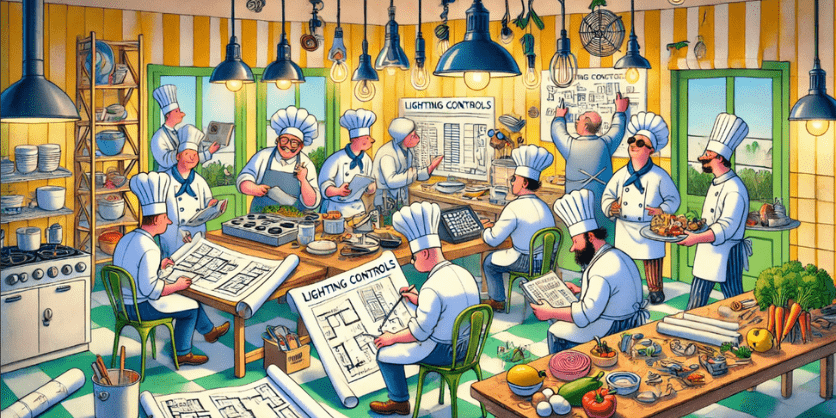Understanding Roles in Construction Projects From Bidding Through Completion: A Recipe for Success

By Emily Lai, LC
Construction projects are a lot like hosting a giant dinner party: you need a clear recipe, the right ingredients, and a team of chefs who actually talk to each other. The stars of the show include the architect, electrical engineer, lighting controls sales rep, distributor, and electrical contractor. Each has a role in cooking up the project, but things get spicy when the recipe – the construction documents – hits the bidding table.
Let’s explore who’s in the kitchen, what happens when the recipe goes to the bidding stage, and how to avoid serving a half-baked project.
Who’s in the Kitchen?
- The Architect: The head chef, who creates the vision and designs the “menu” (building aesthetics) and plating (layout). They set the stage for the meal, but rely on others to bring the flavors to life.
- The Electrical Engineer: The sous chef, responsible for the technical magic like seasoning the electrical systems to code compliance. They specify the lighting control “ingredients” and how they’re cooked (installed).
- The Manufacturer: The farmer, behind every good dish is a farmer producing the best ingredients and using quality assurance practices.
- The Lighting Controls Sales Rep: The spice merchant, who helps engineers pick just the right flavors (products). They ensure the blend works and fits the project’s budget, acting as a helpful consultant along the way.
- The Distributor: The grocer, who supplies the ingredients. They haggle for discounts, manage delivery schedules, and ensure no one is left holding stale bread (materials).
- The Electrical Contractor: The kitchen manager, who juggles budgets, schedules, and the team of cooks. They aim to serve the dish (project) on time and under budget, with a side of profit.
When Construction Documents Hit the Bidding Table
Once the architect and electrical engineer finalize the construction documents, it’s like a recipe handed out to multiple chefs. Contractors use these to whip up bids, which boil down to two main ingredients: materials and labor. Here’s how the process works:
- The Price Hunt: Contractors send requests for pricing to distributors, who then fetch costs from lighting controls manufacturers. Think of it as hunting down the best deals on premium olive oil.
- Cost Stew: Contractors mix material costs with labor, overhead, and profit margin. The trick? Keeping the profit margin tasty without making the client choke.
- Value Engineering (a.k.a. Substitution Sleight of Hand): Sometimes contractors propose swapping out filet mignon for ground chuck. If done well, it’s still delicious. If not, it could ruin the meal (or project).

Strategies for Success (and Sneaky Shortcuts)
1. Value Engineering: The Ingredient Swap
This strategy is like a chef suggesting a cheaper wine for cooking. The contractor proposes alternatives to specified products, keeping costs down while ensuring the dish still tastes good (functions properly). But watch out — if the swap doesn’t meet the design intent or building codes, it’s like using sugar instead of salt.
2. Bundling & Negotiation: The Bulk Buy
Distributors offer contractors discounts for buying in bulk — fixtures, controls, and wiring all bundled together. It’s like getting a combo meal instead of à la carte. Contractors may sweeten the deal further by committing to one distributor, which saves money and adds competition to their bid.
3. Change Orders: The Extra Sauce
Once the project is in motion, contractors sometimes rely on change orders — like asking for an extra fee to drizzle truffle oil over your pasta. These arise when project scope changes or surprises pop up. While they boost profits, too many can cause delays and annoy the client.
When the Meal Goes South
Even the best-planned dinner party can end in disaster if no one follows the recipe — or if the head chef forgets to buy the right ingredients. Here’s how projects can go off the rails:
1. Non-Compliant Substitutions: The Ingredient Fail
If the electrical engineer isn’t paying attention, a contractor might swap out a key product for something cheaper that doesn’t work as intended. For example, substituting a networked lighting control system for a stand-alone setup is like serving ketchup instead of marinara — it’s not going to work with the spaghetti.
2. Unrealistic Costs: Champagne Taste, Beer Budget
Sometimes engineers specify expensive or hard-to-find products without realizing the cost. This can scare off bidders or lead to delays as contractors scramble to find affordable alternatives.
3. Lead Time Missteps: The Missing Cake
Distributors manage the timing of materials, but if lead times aren’t communicated properly, key ingredients could arrive too late. Imagine ordering a birthday cake and getting it the day after the party. Projects face similar frustrations with long-lead-time specialty products.
Collaboration: The Secret Sauce
The recipe for project success requires teamwork. Regular coordination ensures all ingredients are in place and potential hiccups are addressed early. Lighting controls sales reps often provide on-site support during installation, helping contractors configure and commission systems. Think of it as a sous chef swooping in to fix an over-salted soup.
Conclusion
Construction projects are like elaborate meals, requiring the right blend of vision, planning, and execution. While value engineering and bundling help keep costs down, engineers must remain vigilant to ensure substitutions meet the design intent. Clear communication and collaboration between the architect, engineer, contractor, and distributor keep the dish on track to deliver a satisfying project instead of a recipe for disaster.
The next time that you are part of a construction project, think of yourself as part of a kitchen brigade. Play your role well, keep the flavors balanced, and everyone gets to enjoy a successful feast.
About the Author
Emily Lai, LC, is Commercial Regional Sales Manager at ETC
Additional articles by Emily Lai







